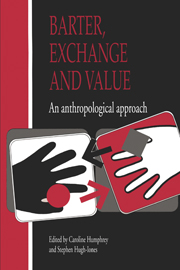Book contents
- Frontmatter
- Contents
- List of figures
- List of contributors
- 1 Introduction: Barter, exchange and value
- 2 Politicised values: the cultural dynamics of peripheral exchange
- 3 Yesterday's luxuries, tomorrow's necessities: business and barter in northwest Amazonia
- 4 Some notes on the economics of barter, money and credit
- 5 Fair dealing, just rewards: the ethics of barter in North-East Nepal
- 6 Inter-tribal commodity barter and reproductive gift-exchange in old Melanesia
- 7 Qualified value: the perspective of gift exchange
- Index
1 - Introduction: Barter, exchange and value
Published online by Cambridge University Press: 05 June 2012
- Frontmatter
- Contents
- List of figures
- List of contributors
- 1 Introduction: Barter, exchange and value
- 2 Politicised values: the cultural dynamics of peripheral exchange
- 3 Yesterday's luxuries, tomorrow's necessities: business and barter in northwest Amazonia
- 4 Some notes on the economics of barter, money and credit
- 5 Fair dealing, just rewards: the ethics of barter in North-East Nepal
- 6 Inter-tribal commodity barter and reproductive gift-exchange in old Melanesia
- 7 Qualified value: the perspective of gift exchange
- Index
Summary
At a dinner-party last year a Rumanian dealer in primitive art, based in Paris, described his delightful trip to the depths of the Celebes. ‘I often have to trade’, he said. ‘Just a month ago, for example, I discovered a wonderful carving of a god but the owner wouldn't sell it to me. I had to have it. He wouldn't take money at any price I offered him. He wanted a pair of two-year-old oxen, nothing more and nothing less.’ ‘So what did you do?’ ‘Oh, there was a market round the corner and I sent a man down there to buy the oxen. I couldn't go myself, of course, or the price would have shot up. I took the oxen round and got the carving.’
What the dealer called ‘trade’ is an example of barter which displays some of a range of features often associated with this kind of exchange. (a) The focus is on demand for particular things which are different in kind; in other cases it may be for services exchanged for goods or other services. (b) The protagonists are essentially free and equal, either can pull out of the deal and at the end of it they are quits, (c) There is no criterion by which, from the outside, it can be judged that the oxen are equal in value to the carving.
Information
- Type
- Chapter
- Information
- Barter, Exchange and ValueAn Anthropological Approach, pp. 1 - 20Publisher: Cambridge University PressPrint publication year: 1992
Accessibility standard: Unknown
Why this information is here
This section outlines the accessibility features of this content - including support for screen readers, full keyboard navigation and high-contrast display options. This may not be relevant for you.Accessibility Information
- 48
- Cited by
